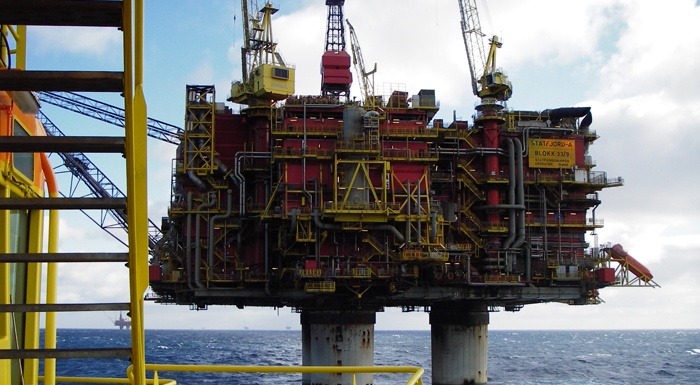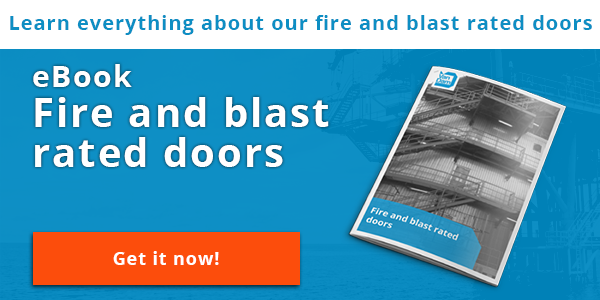
The NORSOK standard for architectural components and equipment is one of the leading standards in the oil & gas industry and defines the minimum functional requirements for design and construction.
The Norwegian oil and gas industry requires different and very specific needs and regulations with regards to architectural components. Therefore, the NORSOK standard provides specific additions and supplements to the existing (inter)national standards within this market.
Fire and blast rated doors are an essential part of the overall architectural design of an on- or offshore structure. NORSOK proof doors are applied worldwide in varying environmental conditions. The strength of a NORSOK proof door lies in the strict and reliable construction and operation, which has been proven over and over again within the industry.
There are certain requirements a NORSOK door has to comply with. Read them below.
1. General requirements according to the NORSOK standard
There are quite a few basic general requirements which are expected to be met:
- Doors and hardware should be designed and arranged in such a way that potential injury to persons is eliminated;
- Door assemblies should be easily operable in a hazardous or accidental situation;
- Doors should have a clear opening of at least 750 mm width and 2050 mm height;
- Doors to cabin bathrooms, toilets, and doors that are not escape routes for more than one person may have a width of less than 750 mm;
- Panic bars should be provided on doors in areas where there is a risk of congestion or panic;
- Threshold detailing and door arrangement should stop all ingress of water from decks;
- Automatic opening devices should be installed on doors used frequently for transport and handling of goods;
- If a hangar door is required for the installation, it should be adequately dimensioned regarding strength, fire rating and exposure to use.
Furthermore, during the design phase, a door schedule should be developed and continuously updated throughout the project in order to specify all required information.
Also, all doors should be supplied by the same company, in accordance with operator/company requirements. The only exception to this requirement are the B15 type lightweight doors and special doors.
2. Door opening force according to the NORSOK standard
The initial force required to open a door should be low in order to ensure fast and easy evacuation during fire events. Opening forces are measured by a dynamometer and is specified in Newton.
In NORSOK, there are two kinds of requirements for opening forces. One specifies the maximum opening forces for doors in frequent use (used at least 10 times a day). The other requirement specifies the maximum opening forces for all other doors.
For doors in frequent use:
- Hinged doors: 65 N
- Sliding doors: 50 N
For all other doors:
- Hinged doors: 130 N
- Sliding doors: 105 N
In accidental situations, the maximum opening force should never exceed 250 N for doors in main escape routes. During the design of such doors, the materials and construction methods used should eventually result in doors as light as possible.
3. Fire rating and acoustic requirements according to the NORSOK standard
Fire ratings and sound reduction requirements should be the same as the division in which they are installed. A lower sound reduction value may be accepted only if it meets the required sound reduction value (Rw) for the whole division.
4. Door materials according to the NORSOK standard
Different materials can be used in the construction of a fire and blast rated door. A very important NORSOK requirement is that the used material should ensure that the door is robust and rattle free based on thickness of frames and door leaf plates. These materials should be able to withstand heavy abuse from mechanical and natural forces. The need for repair and maintenance should be minimal.
The materials and requirements to be used are:
- Carbon steel: in accordance with NS-EN 10025, S235 JRG2 or equivalent;
- Stainless steel: type AISI 316L, or alternatively AISI 316 with a maximum carbon content of 0,05 %. The stainless steel material shall be of the white pickled and passivated condition;
- Aluminum: seawater resistant type;
- Alternative materials: may be used, as long as such materials comply with all relevant requirements.
The surface finish of the door should be stain resistant and should not be painted or coated. After installation, the (heavy duty) door should be able to withstand weld spatter, angle grinding grit and potential damage from other construction activities.
5. Extra requirements according to the NORSOK standard
There are also some extra requirements which could be applied to doors according to the NORSOK standard. First extra requirements is that all external doors should be tested for weathertightness and gastightness and shall not exceed 0,5 m3/m2 h at 50 Pa (5 x 10 -4 bar) over-pressure.
Other extra requirements are that the doors shall have a low threshold H < 25 mm and that the thresholds should be made of stainless steel (covered).
Conclusion
A lot more information on doors can be found in the NORSOK standard. Each door has its own design requirements, fire rating requirements, blast requirements, material requirements, etc. One needs to be aware of all these rules in order to provide the highest level of protection and safety to people and equipment.
Want to know how we can help and guide you in choosing the right requirements for NORSOK proof doors?







